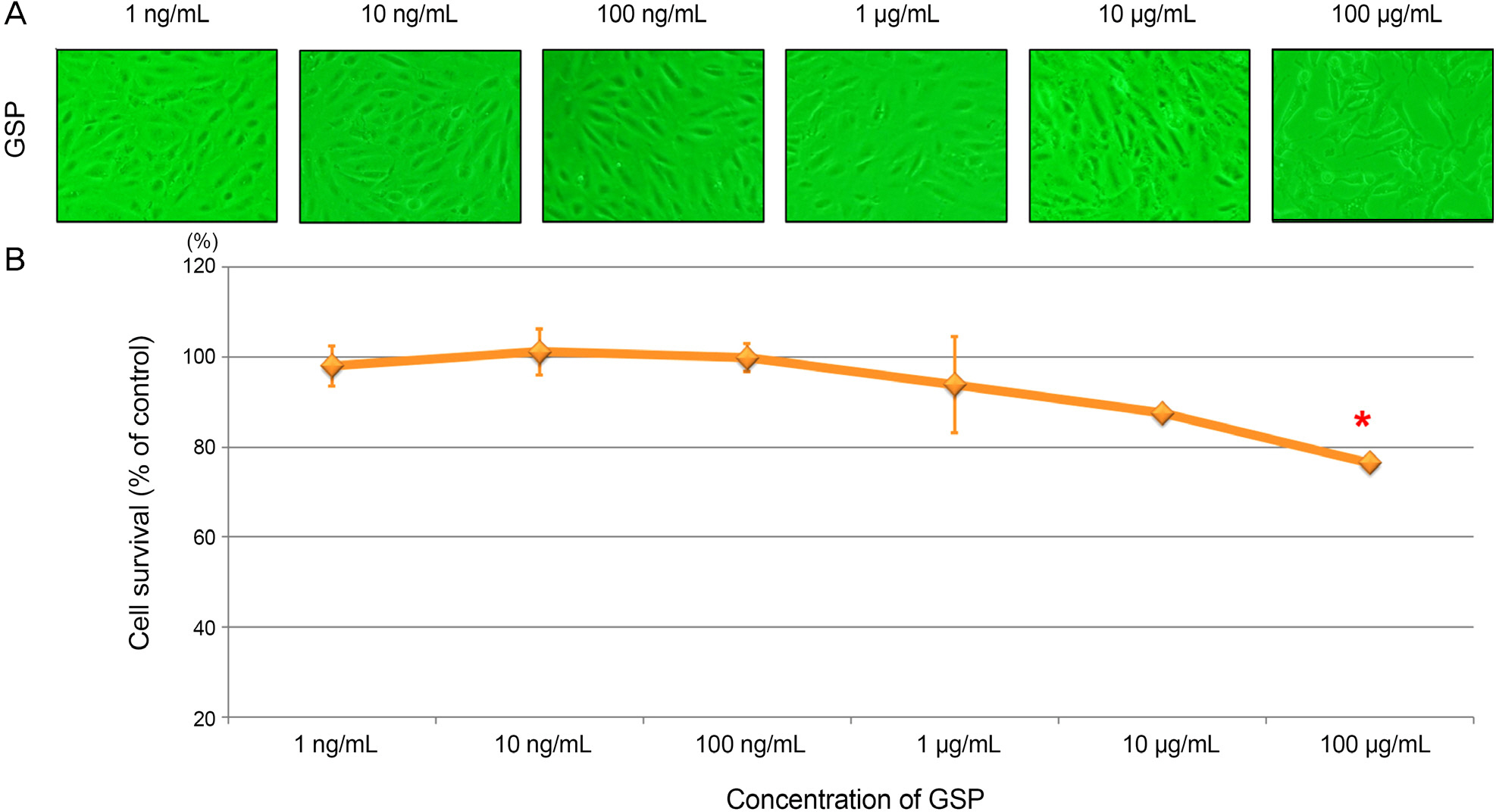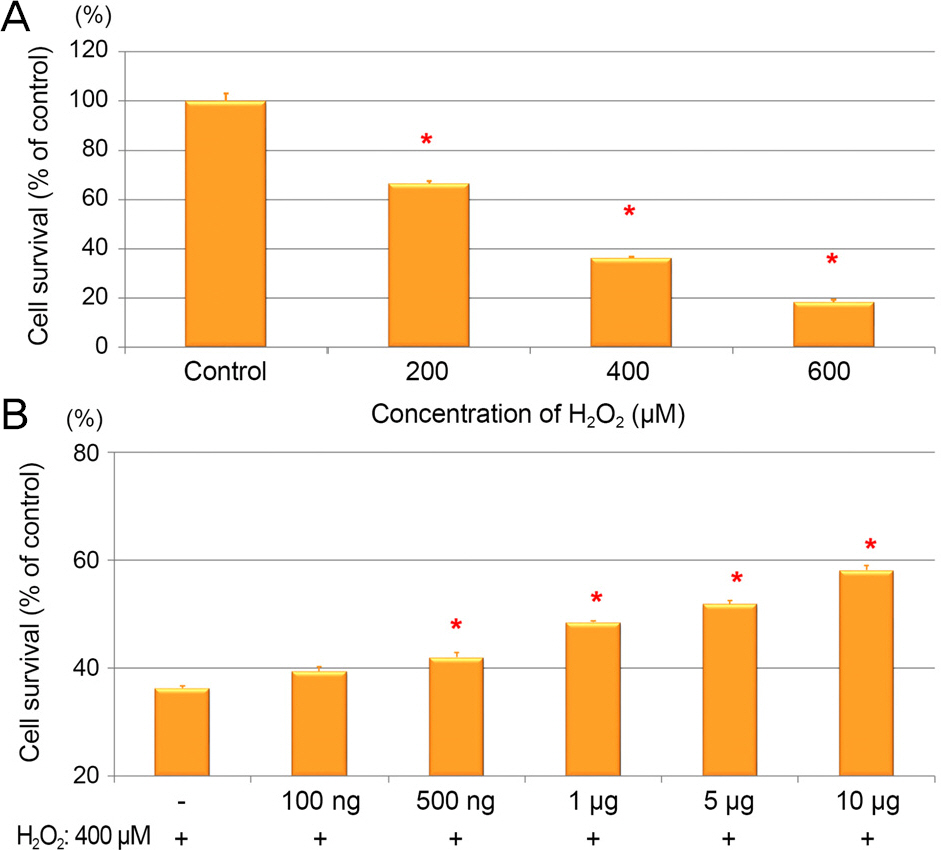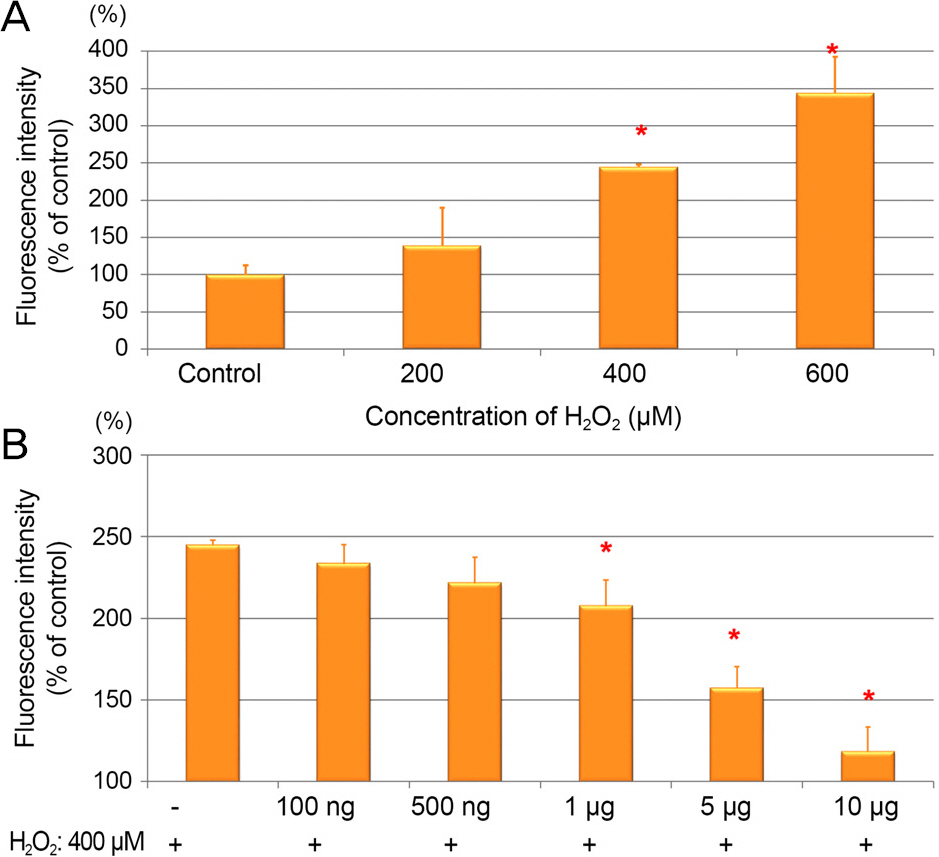J Korean Ophthalmol Soc.
2016 Jan;57(1):106-112. 10.3341/jkos.2016.57.1.106.
Cytoprotective Effect of Polyphenolic Compounds against Oxidative Stress in Cultured Retinal Pigment Epithelial Cells
- Affiliations
-
- 1Department of Ophthalmology, Kyung Hee University Medical Center, Kyung Hee University School of Medicine, Seoul, Korea. hwkwak@khu.ac.kr
- KMID: 2213851
- DOI: http://doi.org/10.3341/jkos.2016.57.1.106
Abstract
- PURPOSE
Grape seed-derived polyphenols (GSPs) provide a concentrated source of polyphenols having antioxidant capacity. In this study we investigated the cytoprotective effect of GSP against oxidative stress-induced cell damage in cultured human retinal pigment epithelial (RPE) cells.
METHODS
Cultured adult retinal pigment epithelium (ARPE)-19 cells were incubated with GSP from Vitis vinifera (0.1, 0.5, 1, 5 or 10 microg/mL) for 24 hours and treated with hydrogen peroxide (H2O2, 0.4 mM) for 24 hours to induce oxidative stress. Cell viability was measured using 3-(4, 5-dimethylthiazol-2-yl)-2, 5-diphenyltetrazolium bromide (MTT) assay. Intracellular reactive oxygen species (ROS) was quantified using 2',7'-dichlorofluorescein diacetate (DCF-DA) fluorescence.
RESULTS
The percentage of viable RPE cells was significantly lower in cultures treated with H2O2 0.4 mM than in control cultures. GSP significantly reduced H2O2-induced cell death in a dose dependent manner. GSP at 0.1, 0.5, 1, 5 and 10 microg/mL significantly reduced cell mortality due to the treatment with H2O2. Intracellular ROS production increased significantly in cultures treated with H2O2 0.4 mM compared with control. There was a significant dose-dependent decrease in intracellular ROS levels after treatment of RPE with GSP.
CONCLUSIONS
GSP, a natural polyphenolic compound, can protect RPE cells from H2O2-induced oxidative stress and reduce intracellular ROS production by scavenging free radicals. This suggests potential effects of polyphenolic compounds against retinal diseases associated with oxidative stress.
Keyword
MeSH Terms
-
Adult
Cell Death
Cell Survival
Epithelial Cells*
Fluorescence
Free Radicals
Grape Seed Extract
Humans
Hydrogen Peroxide
Mortality
Oxidative Stress*
Polyphenols
Proanthocyanidins
Reactive Oxygen Species
Retinal Diseases
Retinal Pigment Epithelium
Retinaldehyde*
Vitis
Free Radicals
Grape Seed Extract
Hydrogen Peroxide
Polyphenols
Proanthocyanidins
Reactive Oxygen Species
Retinaldehyde
Figure
Reference
-
References
1. Devore EE, Kang JH, Breteler MM, Grodstein F. Dietary intakes of berries and flavonoids in relation to cognitive decline. Ann Neurol. 2012; 72:135–43.
Article2. McCullough ML, Peterson JJ, Patel R. . Flavonoid intake and cardiovascular disease mortality in a prospective cohort of US adults. Am J Clin Nutr. 2012; 95:454–64.
Article3. Wang Y, Stevens VL, Shah R. . Dietary flavonoid and proan-thocyanidin intakes and prostate cancer risk in a prospective cohort of US men. Am J Epidemiol. 2014; 179:974–86.
Article4. Manach C, Scalbert A, Morand C. . Polyphenols: food sources and bioavailability. Am J Clin Nutr. 2004; 79:727–47.
Article5. Takikawa M, Inoue S, Horio F, Tsuda T. Dietary anthocyanin-rich bilberry extract ameliorates hyperglycemia and insulin sensitivity via activation of AMP-activated protein kinase in diabetic mice. J Nutr. 2010; 140:527–33.
Article6. Vepsäläinen S, Koivisto H, Pekkarinen E. . Anthocyanin-en-riched bilberry and blackcurrant extracts modulate amyloid pre-cursor protein processing and alleviate behavioral abnormalities in the APP/PS1 mouse model of Alzheimer's disease. J Nutr Biochem. 2013; 24:360–70.
Article7. Wang J, Ferruzzi MG, Ho L. . Brain-targeted proanthocyanidin metabolites for Alzheimer's disease treatment. J Neurosci. 2012; 32:5144–50.
Article8. Dong X, Li Z, Wang W. . Protective effect of canolol from oxi-dative stress-induced cell damage in ARPE-19 cells via an ERK mediated antioxidative pathway. Mol Vis. 2011; 17:2040–8.9. Li Z, Dong X, Liu H. . Astaxanthin protects ARPE-19 cells from oxidative stress via upregulation of Nrf2-regulated phase II enzymes through activation of PI3K/Akt. Mol Vis. 2013; 19:1656–66.10. Hanneken A, Lin FF, Johnson J, Maher P. Flavonoids protect hu-man retinal pigment epithelial cells from oxidative-stress-induced death. Invest Ophthalmol Vis Sci. 2006; 47:3164–77.
Article11. Kil HK, Song YM, Chun K. The efficacy of vaccinium uliginosum for early age-related macula degeneration. J Korean Ophthalmol Soc. 2013; 54:1255–60.12. Moini H, Rimbach G, Packer L. Molecular aspects of procyanidin biological activity: disease preventative and therapeutic potentials. Drug Metabol Drug Interact. 2000; 17:237–59.
Article13. Vigna GB, Costantini F, Aldini G. . Effect of a standardized grape seed extract on low-density lipoprotein susceptibility to oxi-dation in heavy smokers. Metabolism. 2003; 52:1250–7.
Article14. Gabetta B, Fuzzati N, Griffini A. . Characterization of proan-thocyanidins from grape seeds. Fitoterapia. 2000; 71:162–75.
Article15. Pieters R, Huismans DR, Leyva A, Veerman AJ. Adaptation of the rapid automated tetrazolium dye based (MTT) assay for chemo-sensitivity testing in childhood leukemia. Cancer Lett. 1988; 41:323–32.
Article16. Uddin S, Ahmad S. Dietary antioxidants protection against oxida-tive stress. Biochem Educ. 1995; 23:2–7.
Article17. Jerome-Morais A, Diamond AM, Wright ME. Dietary supple-ments and human health: for better or for worse? Mol Nutr Food Res. 2011; 55:122–35.18. Schraermeyer U, Heimann K. Current understanding on the role of retinal pigment epithelium and its pigmentation. Pigment Cell Res. 1999; 12:219–36.
Article19. Cai J, Nelson KC, Wu M. . Oxidative damage and protection of the RPE. Prog Retin Eye Res. 2000; 19:205–21.
Article20. Lee JH, Kim JW. Effect of glucose on the production of reactive oxygen species in retinal pigment epithelial cells. J Korean Ophthalmol Soc. 2010; 51:276–81.
Article21. Murota K, Mitsukuni Y, Ichikawa M. . Quercetin-4'-glucoside is more potent than quercetin-3-glucoside in protection of rat in-testinal mucosa homogenates against iron ion-induced lipid peroxidation. J Agric Food Chem. 2004; 52:1907–12.
Article22. Kook D, Wolf AH, Yu AL. . The protective effect of quercetin against oxidative stress in the human RPE in vitro. Invest Ophthalmol Vis Sci. 2008; 49:1712–20.
Article23. Nguyen T, Sherratt PJ, Pickett CB. Regulatory mechanisms con-trolling gene expression mediated by the antioxidant response element. Annu Rev Pharmacol Toxicol. 2003; 43:233–60.
Article24. Tanito M, Masutani H, Kim YC. . Sulforaphane induces thio-redoxin through the antioxidant-responsive element and attenuates retinal light damage in mice. Invest Ophthalmol Vis Sci. 2005; 46:979–87.
Article25. King RE, Kent KD, Bomser JA. Resveratrol reduces oxidation and proliferation of human retinal pigment epithelial cells via ex-tracellular signal-regulated kinase inhibition. Chem Biol Interact. 2005; 151:143–9.
Article26. Singh S, Aggarwal BB. Activation of transcription factor NF-kap-pa B is suppressed by curcumin (diferuloylmethane) [corrected]. J Biol Chem. 1995; 270:24995–5000.27. Li MH, Jang JH, Sun B, Surh YJ. Protective effects of oligomers of grape seed polyphenols against beta-amyloid-induced oxidative cell death. Ann N Y Acad Sci. 2004; 1030:317–29.28. Zhang B, Osborne NN. Oxidative-induced retinal degeneration is attenuated by epigallocatechin gallate. Brain Res. 2006; 1124:176–87.
Article29. De Marchi U, Biasutto L, Garbisa S. . Quercetin can act either as an inhibitor or an inducer of the mitochondrial permeability transition pore: a demonstration of the ambivalent redox character of polyphenols. Biochim Biophys Acta. 2009; 1787:1425–32.
Article30. Wätjen W, Michels G, Steffan B. . Low concentrations of fla-vonoids are protective in rat H4IIE cells whereas high concen-trations cause DNA damage and apoptosis. J Nutr. 2005; 135:525–31.31. Bouayed J, Bohn T. Exogenous antioxidants - double-edged swords in cellular redox state: Health beneficial effects at physio-logic doses versus deleterious effects at high doses. Oxid Med Cell Longev. 2010; 3:228–37.32. Age-Related Eye Disease Study Research Group A randomized, placebo-controlled, clinical trial of high-dose supplementation with vitamins C and E, beta carotene, and zinc for age-related mac-ular degeneration and vision loss: AREDS report no. 8. Arch Ophthalmol. 2001; 119:1417–36.33. Age-Related Eye Disease Study 2 Research Group Lutein + zeax-anthin and omega-3 fatty acids for age-related macular degener-ation: the Age-Related Eye Disease Study 2 (AREDS2) random-ized clinical trial. JAMA. 2013; 309:2005–15.
- Full Text Links
- Actions
-
Cited
- CITED
-
- Close
- Share
- Similar articles
-
- The Effect of 5-Fluorouraci1 on the Activity of the Retinal Pigment Epithelium in Vitro
- Culture of Retinal Pigment Epithelial Cells on Collagen Membrane
- Effect of Oxidative Stress on the Expression of Gelatinases in Cultured RPE
- Growth Patterns of Human Retinal Pigment Epithelium in Vitro
- Effects of Simvastatin on the Expression of VEGF in Human Retinal Pigment Epithelial Cells





